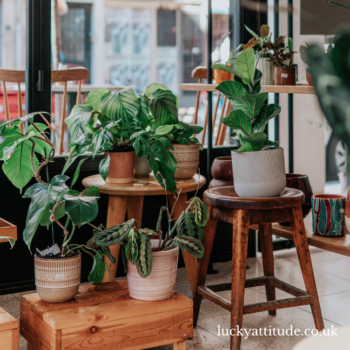How To Keep Your Potted Plants Alive

Do you have problems keeping your plants alive?
With a little practice, anyone can become a pro gardener.
Keeping potted plants alive requires attention, care, and understanding of the specific needs of each plant species.
Here are some general guidelines to help you maintain healthy potted plants:
Choose the right pot for your houseplants
Your pots should have a hole in the bottom, which will help your plants not retain excess water; if not, the extra water will be trapped in the soil, which is not good for your plant’s health.
Drainage is very important for any plant, so you should pay extra attention to this aspect.
The signs that your flower is too wet and has a drainage problem can be noticed if the soil is damp and the plant looks droopy and wilted.
Also, plants should have enough space in which to grow freely. Otherwise, the plant will likely die because it doesn’t have a good environment, so this is why pots should be large enough to give room for the roots to grow and stretch.
The same applies to balcony planters because although plants from this area benefit from a more natural habitat than the ones kept indoors, they still need a large pot to remain healthy.
Use appropriate soil for the plant
Good soil is vital for any plant, so you should pay extra attention to this step.
Don’t scoop some soil found in your backyard, but instead, buy a specialized one for potted greeneries.
As the alternatives on the market often contain fertilizers and extra nutrients, your plant will benefit from a happier and longer life. Also, ensure the soil has organic compost and isn’t sandy or compacted.
You will need to fertilize the ground periodically, especially in spring and summer, as then it is the time when plants grow the most.
Keep in mind that over-fertilizing will burn the roots of your plants, and some of the components will have negative effects if they are in a bigger quantity. For example, if the nitrogen content is large, the plants can have a lot of leaves, but the flowers will be fewer.
Water your plant appropriately
Understand your plant’s water requirements (some like moist soil, while others prefer drier conditions).
Water when the top inch of soil feels dry for most plants, but adjust based on the plant’s needs.
Water thoroughly until water drains out of the bottom, but avoid leaving the pot sitting in standing water and rotting the roots.
Watering can be tricky if you are new and just discovered your love for plants.
So, if the dirt begins to feel crumbly or dry, it may be a good time for watering; otherwise, if it is still damp, the flowers can wait some time.
Don’t worry if it seems complicated, and you fear you will not realize in which scenario your plant is, as with practice, you will learn your plants’ needs very quickly.
Have patience with yourself, as in the beginning, figuring out how much water they need is always harder, as each species is different, and two plants will not behave the same.
Ensure plenty of daylight
Besides watering and fertilised soil, plants also need plenty of light, which is indispensable.
Although each has its preferences and favors a very sunny or dark environment, no plant will grow without any light whatsoever.
When they don’t benefit from sunlight, they can’t produce chlorophyll, and because of that, in a lot of times, the indoor plants transform themselves and turn pale green and even yellow or white.
Before buying a plant, you would search for information about the quantity of light it needs and choose one according to the light you have in your house.
Place plants in appropriate light conditions (full sun, partial sun, shade) based on their requirements.
Monitor how much light your plants are receiving and adjust their placement accordingly.
Some plants enjoy darker areas, like Monstera Deliciosa, so you can opt for this species if you don’t have plenty of natural light.
Repot overgrown plants
Repot plants when they become root-bound or outgrow their current containers. When roots have grown and lack space, it is time for repotting.
Choose a slightly larger pot and fresh potting soil.
Also, as you are at this step, you can divide the stems and create new plants to replace the old ones.
Typically greeneries need to change the pots every 12 to 18 months, depending on the species and how fast they are growing.
When the time for repotting comes, you must choose a planter between 1 and 3 inches larger than the current one because if you choose a bigger one, you will likely overwater the plant.
If the repotting time has come and your plants want a new home, you need to search for high-quality planters that will ensure your plants stay strong and healthy, so you can choose from the many options you can find at https://www.elho.com/en.
Final words
Keeping your potted plants alive is not hard, but you need to consider the steps that ensure they stay safe and strong. If you follow these guidelines, you will have beautiful flowers all year long, and you will be envied by anyone who sees the beauty of your greeneries.
